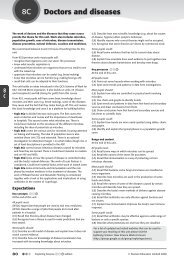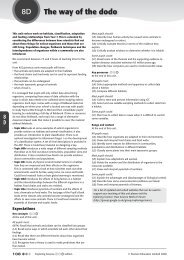8E TEACHER GUIDE.pdf - swallowhillresources
8E TEACHER GUIDE.pdf - swallowhillresources
8E TEACHER GUIDE.pdf - swallowhillresources
- No tags were found...
You also want an ePaper? Increase the reach of your titles
YUMPU automatically turns print PDFs into web optimized ePapers that Google loves.
Still water<strong>8E</strong>eblack plasticfreshlydug holesmallstonecleancontainerlargestonessmall stoneto weigh downcentre of plasticframe madefrom canesand stringblack plasticfastened to caneswith sticky tapefreshly dug earth Ethanol is highly flammable. Completely Denatured Alcoholis highly flammable and harmful. Eye protection should be worn.Ensure that pupils smell the distillate following the recommendedmethod.Resources (per group)Long neck, side-arm conical flask; Liebig condenser; watersupply; anti-bumping granules; thermometer and bung;electric heating mantle; mixture of 20 cm 3 ethanol or CompletelyDenatured Alcohol to 150 cm 3 water; heatproof mat; eyeprotection.<strong>8E</strong>eResources (per group)Black bin liners; garden trowel; string; canes/sticks; stones;sticky tape; clean container (e.g. plastic cup/jam jar); access toopen ground.Explaining tasks1: Pupil’s Book pages 72–73Start by discussing evaporation, and the fact that it separates aliquid from a dissolved solid, but is only any use if you want thesolid. What happens if it is the pure liquid you want? Discusswhere the liquid has gone when it evaporates, and how it could be‘trapped’ and condensed.These pages look at the process of distillation. Worksheet <strong>8E</strong>e(1) isthe Access Sheet.2: Distillation (AT)Worksheet <strong>8E</strong>e(3) provides a diagram of the distillation apparatusfor pupils to label and to add their own explanations of how it works.• The AT video link on page 72 opens Distilling inky water – thisprovides an activity where labels have to be dragged and droppedonto a diagram of the distillation apparatus.• The AT animation link on page 72 opens Distillation – thisprovides an animation of distillation in terms of particles.3: Practical: Liebig condenserDemonstrate the distillation of inky water, using a Liebig condenser.Pupils should be told that ink is often made by dissolving solids inwater. Heat the flask gently whilst the mixture boils. Point out thereading on the thermometer, condensation inside the condenserand collection of the pure water. Discuss with pupils the reasonwhy the water in the cooling jacket goes in at the bottom. Eye protection should be worn.ResourcesLong neck, side-arm round-bottomed flask; Liebig condenser;water supply; anti-bumping granules; thermometer andbung; Bunsen burner; ink/water mixture; heatproof mat; eyeprotection.4: Practical: Distilling alcohol/waterDemonstrate the distillation of an alcohol/water mixture using anelectric heating mantle to avoid alcohol fumes igniting and givinga flash flame. Demonstrate to pupils how to smell chemicals safely(fill the lungs with clean air, then wave a hand above the containerto waft the smell towards you). Identify alcohol by smell (do notallow pupils to take a large sniff or taste it). This demonstration canbe more effective if Completely Denatured Alcohol (CDA) is used(but be aware that this is very smelly!) – the dye remains in theflask.5: Pupil’s Book pages 74–75 (AB/AT)These pages look at how cities are supplied with water, looking firstat where the water for Manchester comes from and consideringthe environmental and human consequences of different meansof supplying water. They then go on to briefly discuss the use ofdesalination plants for supplying drinking water.Worksheet <strong>8E</strong>e(2) is the Access Sheet.• The AT video link on page 74 opens Supplying water – the clipshows Tina Dijkstal explaining where Southern Water gets itswater and contrasts this with water companies in the south westof England.• The AT animation link on page 75 opens Desalination – this is adiagram of a desalination plant with labels selected from dropdownmenus.6: Pupil’s Book page 76This page looks at different opinions about the use of water in theUK, and how we can make sure that water supplies in the futureare adequate.• The AT video link on page 76 opens Saving water – this showsTina Dijkstal talking about why there are sometimes watershortages and about some of the ways in which people can useless water in their homes.The Have Your Say box on this page asks pupils to consider howthe government could make sure that the UK has enough water.This can be used as the basis for group discussions or a debate.Refer to Skills Sheet 41 from the Year 7 CHAP for ideas on how torun a debate.Plenaries1: Quick CheckThe Quick Check sheet provides a set of cards summarising thedifferent separation techniques covered in this unit for pupils tomatch up. Incorrect explanations are also included to test theirunderstanding.2: Explaining separation techniques (AB/AT)The AB document link on page 72 opens Separation summary– which provides a table for pupils to complete to summarise thefour different separation methods covered in this unit.Worksheet <strong>8E</strong>e(4) provides a diagram illustrating how filteringworks using the particle model. Pupils are asked to draw similardiagrams to explain how the other ways of separating mixtures work.3: Water purificationTell pupils that the local water company has been receivingcomplaints about the quality of the water, so it is having an openday at its laboratories. It wants to have some information boardsexplaining how it treats water, but it also wants to explain thescience behind the different ways of purifying water or analysing itto see what salts it contains.© Pearson Education Limited 2008 Exploring Science edition 155






